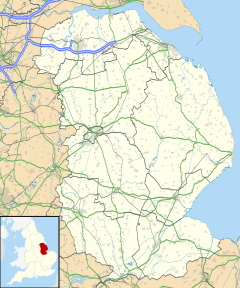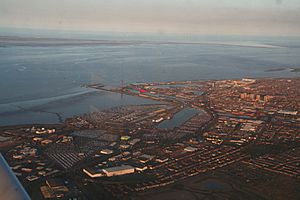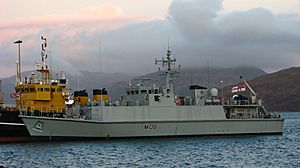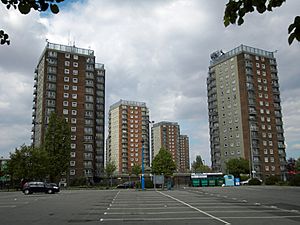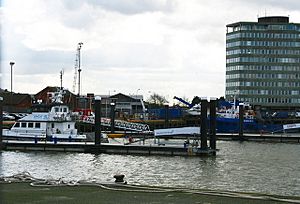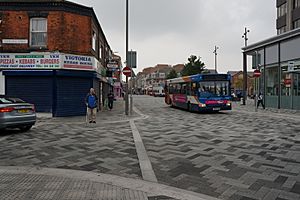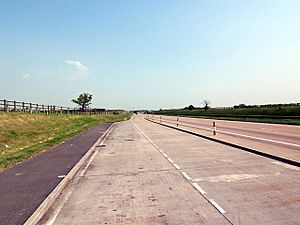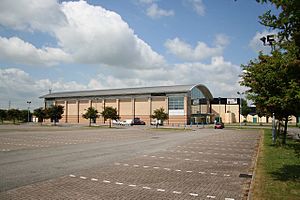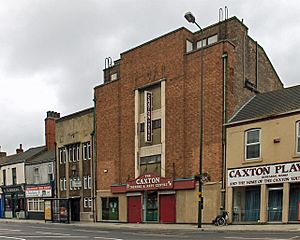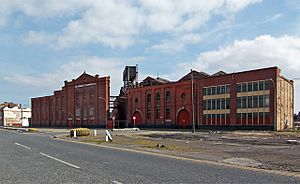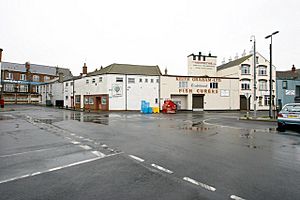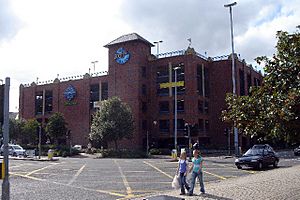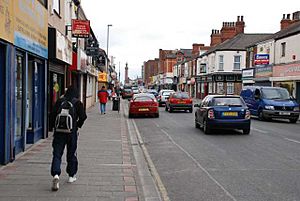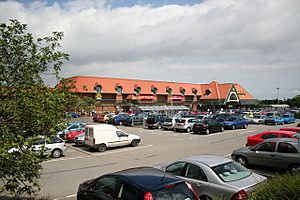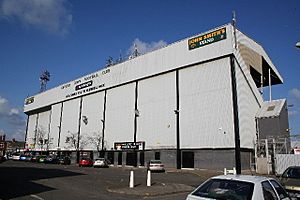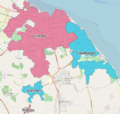Grimsby facts for kids
Quick facts for kids Grimsby |
|
|---|---|
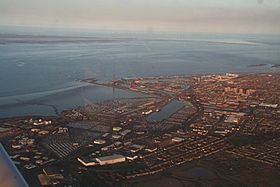 Aerial view of Grimsby |
|
| Population | 88,243 (2011) |
| OS grid reference | TA279087 |
| • London | 140 mi (230 km) S |
| Unitary authority | |
| Ceremonial county | |
| Region | |
| Country | England |
| Sovereign state | United Kingdom |
| Post town | GRIMSBY |
| Postcode district | DN31 – DN34, DN36, DN37, DN41 |
| Dialling code | 01472 |
| Police | Humberside |
| Fire | Humberside |
| Ambulance | East Midlands |
| EU Parliament | Yorkshire and the Humber |
| UK Parliament |
|
Grimsby, also Great Grimsby, is a port town and the administrative centre of North East Lincolnshire, England, on the south bank of the Humber Estuary close to the North Sea. It was the home port for the world's largest fishing fleet by the mid-20th century, but fishing then fell sharply. The Cod Wars denied UK access to Icelandic fishing grounds and the European Union used its Common Fisheries Policy to parcel out fishing quotas to other European countries in waters within 200-nautical-mile (370 km) of the UK coast. Grimsby has since suffered post-industrial decline, but food production has risen since the 1990s. The Grimsby–Cleethorpes conurbation acts as a cultural and economic centre for much of north and east Lincolnshire. Grimsby people are called Grimbarians; the term codhead is also used jokingly, often for football supporters. Great Grimsby Day is 22 January. Grimsby is also the second largest settlement by population in Lincolnshire after Lincoln, with Scunthorpe being the third largest.
Contents
Geography
The town was titled "Great Grimsby" to distinguish it from Little Grimsby, a village about 14 miles (22 km) to the south, near Louth. People from Grimsby are called Grimbarians; the term codhead (plural codheads) is also used jokingly or disparagingly, often with reference to Grimsby football supporters.
The town had a population of 88,243 in 2011. It is physically linked to and forms a conurbation with the adjoining town of Cleethorpes. Some 11,000 of its residents live in the village of Scartho, which was absorbed into Grimsby before 20th-century laws on the green belt were passed. All three areas come under the jurisdiction of the same unitary authority, North East Lincolnshire. It is close to the main terminus of the A180, which ends in Cleethorpes. 22 January is Great Grimsby Day.
Grimsby lies in the national character areas of the Humber, and the Lincolnshire coast and Marshes; it is predominantly low in topography. The town was historically settled on low-lying islands and raised areas of the Humber marsh, and subsequently expanded onto the surrounding marshes as they were drained. The town still has areas named East Marsh and West Marsh. The Lincolnshire Wolds are situated to the south west of the town, from which the town's River Freshney rises.
History
There is some archeological evidence of a small town of Roman workers sited in the area in the second century. Located on the River Haven, which flowed into the Humber, this provided an ideal location for ships to shelter from approaching storms. It was also well situated to exploit the rich fishing grounds in the North Sea.
Vikings
Grimsby was settled by Danes sometime in the 9th century AD. According to legend, the name Grimsby derives from the name Grim, a Danish fisherman, the suffix -by being the Old Norse word for village. The legendary founding of Grimsby is described in Lay of Havelock the Dane, but historians consider this account to be myth.
In Norse mythology, Grim (Mask) and Grimnir (Masked One) are names adopted by the deity Odin (Anglo-Saxon Woden) when travelling incognito amongst mortals, as in the short poem known as 'Grimnir's Sayings' (Grimnismal) in the Poetic Edda. The intended audience of the Havelock tale (recorded much later in the form of The Lay of Havelock the Dane) may have understood the fisherman Grim to be Odin in disguise. The Odinic name 'Grimr/Grim' occurs in many English placenames within the historical Danelaw and elsewhere in Britain, examples being the numerous earthworks named Grimsdyke. As other British placenames containing the element Grim are explained as referring to Woden/Odin (e.g. Grimsbury, Grimspound, Grime's Graves, Grimsditch, Grimsworne), Grimsby is likely to have the same derivation.
Grimsby is listed in the Domesday Book as having a population of around 200, a priest, a mill and a ferry.
Medieval period
During the 12th century, Grimsby developed into a fishing and trading port, at one point ranking twelfth in importance to the Crown in terms of tax revenue. The town was granted its charter by King John in 1201. The first mayor was installed in 1202.
Grimsby is noted in the Orkneyinga Saga in this Dróttkvætt stanza by Kali Kolsson:
Vér hǫfum vaðnar leirur vikur fimm megingrimmar;
saurs vara vant, er várum, viðr, í Grímsbœ miðjum.
Nú'r þat's más of mýrar meginkátliga látum
branda elg á bylgjur Bjǫrgynjar til dynja.
We have waded in mire for five terrible weeks; there was no lack of mud where we were, in the middle of Grimsby. But now away we let our beaked moose [ship] resound meerily on the waves over the seagull's swamp [sea] to Bergen.
Grimsby does not have town walls. It was too small and was protected by the marshy land around it. However, the town did have a ditch.
In medieval times, Grimsby had two parish churches, St Mary's and St James. Only St James, now known as Grimsby Minster, remains. St James is associated with a folk tale of an Imp who played tricks in the church and was turned into stone by an angel (a similar story is told for Lincoln Cathedral; see Lincoln Imp).
In the mid-14th century, the town benefited from the generosity of Edmund de Grimsby, a local man who became a senior Crown official and judge in Ireland.
In the 15th century, The Haven began to silt up, preventing ships in the Humber from docking. As a result, Grimsby entered a long period of decline which lasted until the late 18th century. By 1801, the population of Grimsby numbered 1,524, around the same size that it had been in the Middle Ages.
Rise of fishing and maritime industry
The Grimsby Haven Company was formed by Act of Parliament in May 1796 (the Grimsby Haven Act) for the purpose of "widening, deepening, enlarging, altering and improving the Haven of the Town and Port of Great Grimsby". After dredging of The Haven and related improvement, in the early 19th century the town grew rapidly as the port was revived. Grimsby's port boomed, importing iron, timber, wheat, hemp and flax. New docks were needed to cope with the expansion. The Grimsby Docks Act of 1845 allowed the necessary building works.
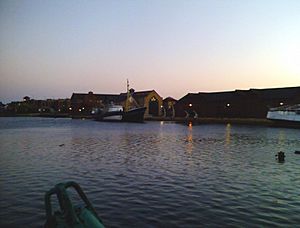
The arrival of the railway in 1848 made it easier to transport goods to and from the port to markets and farms. Coal mined in the South Yorkshire coal fields was brought by rail and exported through Grimsby. Rail links direct to London and the Billingsgate Fish Market allowed for fresh 'Grimsby Fish' to gain renown nationwide. The first true fish dock opened in Grimsby in 1856, and the town became a centre for the development of the commercial fishing industry.
The Dock Tower was completed in 1851, followed by the Royal Dock in 1852. No.1 Fish Dock was completed in 1856, followed by No.2 Fish Dock in 1877. Alexandra Dock and Union Dock were completed in 1879. During this period, the fishing fleet was greatly expanded. In a rare reversal of the usual trends, large numbers of fishermen from the South-East and Devon travelled North to join the Grimsby fleet. Over 40% of these newcomers came from Barking in East London, and other Thames-side towns.
In 1857 there were 22 vessels in Grimsby. Six years later there were 112. The first two legitimate steam trawlers ever built in Great Britain were based in Grimsby. By 1900, a tenth of the fish consumed in the United Kingdom was landed at Grimsby, despite the many smaller coastal fishing ports and villages that also supplied the nation.
The demand for fish in Grimsby grew to such an extent that, at its peak in the 1950s, Grimsby laid claim to the title of the largest fishing port in the world. The population grew from 75,000 in 1901 to 92,000 by 1931.
But the Great Depression and the restructuring of the fishing industry caused a severe decline in employment. The population was fairly stable for the rest of the 20th century.
Second World War
The Royal Dock was used as the UK's largest base for minesweepers to patrol the North Sea. The Admiralty requisitioned numerous trawlers to serve as minesweepers for the Royal Naval Patrol Service. In many cases, their crew were ex-trawlermen, as well as men from the Royal Naval Reserve and Royal Navy volunteers. Trawlers would use the winches and warps from fishing operations to tow a paravane with a cutting jaw through the water in what was known as a 'sweep' to bring mines to the surface and allow for their removal.
The dangers faced by the 'Patrol Service' ensured that it lost more vessels than any other branch of the Royal Navy during the Second World War, with 2,385 lives lost. Grimsby’s Royal Naval Patrol Service veterans financed the construction of a memorial beside the Dock Tower to ensure that the bravery and sacrifice of their comrades is never forgotten.
On 14 June 1943, an early-morning air raid by the Luftwaffe dropped several 1,000 kg bombs, 6,000 incendiary bombs and more than 3,000 Butterfly Bombs in the Grimsby area. Ninety-nine people died that night and in total, Second World War bombing raids in Grimsby and Cleethorpes killed a total of 196 persons. In addition 184 people were seriously injured. The Butterfly Bombs, which littered the area, hampered fire-fighting crews trying to reach locations damaged by the incendiary bombs. The search for recovery of bodies continued for a month after the raid.
HMS Grimsby is a Sandown class minehunter (commissioned in 1999) currently in service in the Royal Navy.
Post-Second World War
Following the pressures placed on the industry during the Cod Wars, many Grimsby firms decided to cease trawling operations from the town. The sudden demise of the Grimsby fishing industry brought an end to a way of life and community that had lasted for generations. The loss of the fishing industry brought severe social problems to the town, in a similar manner to that seen in the coalfields following the decline of mining. Huge numbers of men became redundant, highly skilled in jobs that no longer existed, and they struggled to find work ashore. As with the Ross Group, some firms concentrated on expanding industries within the town, such as food processing.
Grimsby's trawling days are remembered through the artefacts and permanent exhibits at the town's Fishing Heritage Centre. The preserved 1950s trawler, Ross Tiger, is located here. Few fishing vessels still operate from Grimsby's docks, but the town maintains a substantial fish market important in Europe.
Since the mid-1980s, the former Humber ferry, PS Lincoln Castle, has been moored in Alexandra Dock. She was used during this time as a pub\restaurant. Although her design and status as Britain's last coal-fired paddle steamer was unique, these operations no longer yielded a profit. The ship was broken up in 2010. Berthed in the Alexandra Dock is the Ross Tiger, the last survivor of what was once the world's largest fleet of sidewinder trawlers.
The town was described in The Daily Telegraph in 2001 as a town "subjected to...many crude developments over the past 30-odd years" and as a town which "seemingly shuns the notion of heritage". Redevelopment was planned as part of Yorkshire Forward's Renaissance Towns Programme; however, Yorkshire Forward was abolished in 2012.
In the early part of the 21st century, the town faced the challenges of a post-industrial economy that was also affected by a decline in the fishing industry: the East Marsh ward of the town is the second most deprived in the country, according to the governmental statistics.
Transport
Grimsby lies 15 miles (24 km) from the nearest motorway, the M180, which continues as A180 into the town and acts as a link with the national motorway network. The town is skirted by the A18, with the A46 passing through to provide a connection towards Lincoln, while the A16 links it to Louth and south and eastern Lincolnshire. The transport infrastructure was described in a report by the European Commission as strong and as a help to Grimsby's transition to a food-processing centre. It was once derided as being "on the road to nowhere" by the writer and critic A. A. Gill.
Buses
Grimsby's bus services are provided by Stagecoach in Lincolnshire, which took over from Grimsby-Cleethorpes Transport (CGT) in 1993. This had been formed in 1957 by a merger of separate Grimsby and Cleethorpes transport undertakings. Stagecoach had all the buses resprayed to their standard livery to replace the colour scheme of orange and white introduced in 1987. GCT ran a mixture of crewed and one-person operated services, but in 1982 the job of conductor was abolished.
In 2005, Stagecoach bought out Lincolnshire Road Car, which served South Killingholme, Louth, Barton-upon-Humber and the Willows Estate. The company is now known as Stagecoach in Lincolnshire. Joint ticketing began with Stagecoach Grimsby-Cleethorpes in May 2006. From September 2006, a new fleet of low-floor single-deckers was introduced, making the fleet an unprecedented 85 per cent low-floor.
The main bus exchange in Grimsby is Riverhead Exchange.
Railways
Grimsby has rail links via Grimsby Town railway station and Grimsby Docks railway station. There is a level crossing in the centre of the town across Wellowgate. TransPennine Express provides direct trains to Manchester Airport via Doncaster and Sheffield, whilst Northern Trains operates services to Barton-upon-Humber, for buses to Hull, and a Saturday service to Sheffield via Retford. Lincoln and Newark are served by East Midlands Railway services that continue to Nottingham on Sunday in the summer months. The service to Cleethorpes runs at least hourly during the day along a single track, passing stations at Grimsby Docks and New Clee.
Erstwhile trams
Grimsby had two tramway networks: the Grimsby District Light Railway and the Grimsby & Immingham Electric Railway.
Grimsby Electric was a normal-gauge tramway opened in 1912 between Corporation Bridge at Grimsby and Immingham. There was no physical connection with the railway system. It provided a passenger service between Grimsby and Immingham until it closed in 1961. It is claimed that once this was controlled by the corporation, it had more interest in supporting the motorbus service, now No. 45.
Grimsby Light Railway opened in 1881 using horse-drawn trams. In 1901, these were replaced with electric tramways. In 1925 the Grimsby Transport Company bought the tramway company and in 1927 moved the depot to the Victoria Street Depot, an old sea plane hangar. This system closed in 1937. The depot continues to be used by Stagecoach, although the old Grimsby Tramways livery is still visible on the front of the building.
Operating in the area until the 1950s was a network of electrically operated trolleybuses served by overhead power lines.
Airport
Humberside Airport is 14 miles (23 km) west of Grimsby and mainly caters for charter holidays. It is popular for general aviation, with five flying clubs based there.
Culture and attractions
Entertainment
Aside from the nightclubs in nearby Cleethorpes, the town centre has undergone a renaissance in the last decade. A number of national pub chains have redeveloped or opened new outlets, including a specially-built complex at the Riverhead which is home to three (originally five) such operations. Prior to the late 1960s many public houses in the area were owned by the local brewer Hewitt Brothers and gave a distinctive local touch but following a takeover in 1969 by the brewer Bass-Charrington these have been re-badged (many times), closed or sold off.
Musical entertainment is found at the Grimsby Auditorium, built in 1995, on Cromwell Road in Yarborough near Grimsby Leisure Centre. The smaller Caxton Theatre is on Cleethorpe Road (A180) in East Marsh near the docks. The Caxton Theatre provides entertainment by adults and youths in theatre. A notable theatre company in the area is the Class Act Theatre Company run by local playwright David Wrightam.
North East Lincolnshire Council has installed a Wi-Fi network covering Victoria Street in central Grimsby. The service provides access to the Internet for the general public on a yearly subscription.
Grimsby's former cinema on Freeman Street closed in 2004, with the Parkway cinema in nearby Cleethorpes serving the town. Plans to build a new cinema in the town have been periodically made since. The Whitgift Film Theatre based in John Whitgift Academy shows a programme of limited release and arthouse films.
Notable places of interest and landmarks
- Corporation Bridge
- Fisherman's Memorial
- Grimsby Docks
- Grimsby Dock Tower
- Grimsby Ice Factory – built in 1898–1901 to provide crushed ice to preserve fish stored in ships at Grimsby's seaport
- Grimsby Institute
- Grimsby Marina
- Grimsby Minster
- Grimsby Town Hall
- Humber Forts
- National Fishing Heritage Centre
- Waltham Windmill
- Weelsby Woods
Grimsby is the site of a Blue Cross Animal Hospital, one of only four in the country; the other three are situated in London. The Grimsby hospital was previously in Cleethorpe Road, but in 2005 it moved to a new building called 'Coco Markus House' in Nelson Street.
Media
The Grimsby Telegraph, with an audited circulation of 40,533 copies (January – June 2004), has the highest circulation of a local newspaper in Grimsby and the surrounding area since it is the only daily newspaper. Its former headquarters are on Cleethorpe Road next to the A180, it is now based in Heritage House near to the Fishing Heritage Centre. The local radio stations are BBC Radio Humberside (which has a studio on Victoria Street manned by Lara King), Lincs FM, Viking FM and the exclusively North East Lincolnshire-based Compass FM. The transmitter for Compass FM and EMAP Humberside (Lincs FM DAB) is on top of a block of flats in East Marsh. Terrestrial television coverage based in the area are the BBC who share the radio facilities on Victoria Street and ITV Yorkshire who have a news unit based in Immingham. Estuary TV (formerly Channel 7 Television) broadcast on Freeview channel 8 and on Virgin Media channel 159 from studios based at the Grimsby Institute.
Grimsby in the media
- Bernie Taupin, who lived in Humberston and Tealby (near Market Rasen) when in his teens, wrote the lyrics to Elton John's 1974 song, "Grimsby" in the Album "Caribou".
- The town has been used as a film location: Scartho Hospital (now Diana, Princess of Wales Hospital), and the Scartho Cemetery entrance, were used in the 1985 film Clockwise; the 2006 film, This Is England was partially set and filmed in Grimsby and other surrounding locations such as Nottingham;.
- Grimsby is a 2016 comedy film starring Sacha Baron Cohen and Mark Strong. It was released by Columbia Pictures in February 2016. No scenes for the film were shot in Grimsby, with scenes of the town filmed in Tilbury, Essex.
- The town was the setting for the second series of the Channel 4 documentary Skint in 2014. The programme follows families and individuals living with the "devastating effects of long-term unemployment".
Flooding
The Environment Agency has awarded Sheffield-based telemetry company CSE Seprol a contract to supply flood warning devices for risk areas in East Anglia. The 18 sirens, at various locations around the flood risk area of Grimsby and Cleethorpes, should reach 25,500 households to warn of portending floods. The sirens will be sounded only in the event of the Environment Agency issuing a severe flood warning for tidal flooding, or if there is a likelihood of the sea defences being breached. The sirens make a variety of sounds, from the traditional wailing sound to a voice message.
Twin cities
Grimsby's twin cities include:
- Tromsø, Norway, since 1961
- Bremerhaven, Germany, since February 1963
- Banjul, The Gambia
- Dieppe, France
- Akureyri, Iceland. In 2007, a friendship and fisheries agreement was signed with Akureyri which according to Ice News, might lead to a twin cities designation in the future.
As a port with extensive trading ties to Continental Europe, the Nordic nations and Baltic Europe, the town plays host to honorary consulates of Denmark, Iceland, and Norway. Swedish and Finnish honorary consulates are located in Immingham, and that of Germany at Barrow-upon-Humber.
The people of Norway send a tree to the town of Grimsby every Christmas since the end of the Second World War. The Norwegian city of Trondheim sent a tree for 40 years until 2003, since then the tree has been donated by the northern Norwegian town of Sortland, and placed in the town's Riverhead Square. During redevelopment of Riverhead Square the tree has been placed in the Old Market Place since 2013.
Economy
The main sectors of the economy are ports and logistics, food processing, specifically frozen foods and fish processing, chemicals and process industries and digital media. Cleethorpes to the east has a tourist industry. To the west along the Humber bank to Immingham there has been large-scale industrial activity since the 1950s, around chemicals and from the 1990s gas-powered electricity generation.
Food industry
Grimsby is strongly linked with the sea fishing industry that once generated wealth for the town. At its peak in the 1950s, it was the largest and busiest fishing port in the world. The Cod Wars with Iceland, and the European Union's Common Fisheries Policy sent this industry into decline for many years. In 1970 around 400 trawlers were based in the port, but by 2013 only five remained, while 15 vessels were being used to maintain offshore wind farms in the North Sea. The town still has the largest fish market in the UK, but most of what is sold is brought overland from other ports or from Iceland by containerisation. Of the 18,000 tonnes of fresh fish sold in Grimsby fish market in 2012, almost 13,000 tonnes, mainly cod and haddock, came from Iceland.
Grimsby houses some 500 food-related companies, as one of the largest concentrations of such firms in Europe. The local council has promoted Grimsby as Europe's Food Town for nearly 20 years. In 1999, the BBC reported that more pizzas were produced than anywhere else in Europe, including Italy.
Grimsby is recognised as the main centre of the UK fish-processing industry; 70 per cent of the UK's fish processing industry is located there. In recent years, this expertise has led to diversification into all forms of frozen and chilled foods. It is one of the largest centres of fish processing in Europe. More than 100 local companies are involved in fresh and frozen fish production, the largest being the Findus Group (see Lion Capital LLP), comprising Young's Seafood and Findus, with its corporate headquarters in the town. Young's is a major employer, with some 2,500 people based at its headquarters. From this base, Young's has a global sourcing operation supplying 60 species from 30 countries.
Traditional Grimsby smoked fish was awarded a Protected Geographical Indication (PGI) in 2009 by the European Union. The traditional process uses overnight cold smoking from sawdust in tall chimneys, roughly 1 by 2 metres (3 ft 3 in by 6 ft 7 in) square and 10m high.
Other major seafood companies include the Icelandic-owned Coldwater Seafood, employing more than 700 across its sites in Grimsby; and Five Star Fish, a supplier of fish products to the UK food market.
The £5.6 million Humber Seafood Institute, the first of its kind in the UK, opened in 2008. Backed by Yorkshire Forward, North East Lincolnshire Council and the European Regional Development Fund, it is managed by the local council. Tenants include the Seafish Industry Authority and Grimsby Institute and University Centre. Greater Grimsby is a European centre of excellence in producing chilled prepared meals, and the area has Europe's largest concentration of cold-storage facilities.
Docks
The Port of Grimsby has been in use since the medieval period. The first enclosed dock, later known as the Old Dock, was built in the 1790s by the Grimsby Haven Company. Major expansion came with the railways and construction of the Royal Dock, Grimsby in the 1840s. A Fish Dock was added in 1857, and the fish docks expanded over the next 80 years. The Old Dock was expanded to form Alexandra Dock in the 1880s. The Kasbah is a historic area between the Royal Dock and Fish Dock marked by a network of streets that remains home to many artisan fish-processing businesses.
Fishing activities were reduced to a fraction of former levels in the second half of the 20th century. The current port has become a centre for car imports and exports, and since 1975 for general cargo. In the early 21st century, it has developed as a wind-farm maintenance base.
Retail
High-street shopping is grouped in central Grimsby between the railway and River Freshney, where Victoria Street acts as a central pedestrianised shopping street with an undercover Freshney Place centre to the north. Freshney Place is visited by 14 million shoppers a year and employs over 2,000 staff. The centre houses over 100 stores, including Marks and Spencer and House of Fraser. Constructed between 1967 and 1971 in a joint venture between the old Grimsby Borough Council and developers Hammerson's UK Ltd., it was known as the Riverhead Centre (so named as the development was adjacent to where the two local rivers, the Freshney and the Haven, meet). Hammerson's UK Ltd began a £100 million redevelopment of the retail centre, doubling it in size. The expanded centre was covered in a glass roof. Two multi-storey car parks were constructed at each end of the centre; with this development, the old Top Town area of Grimsby was effectively privatised and roofed over. Stores are serviced at the first floor by ramps at the western end, which can accommodate even large vehicles. The ramp also provides access to the car park on the roof of the indoor market, which is operated by the local council. Freshney Place won a design commendation in the Refurbishment Category of the 1993 BCSC awards.
In the town centre Bethlehem and Osborne Street are also mixed in use, hosting retail, legal and service functions to the south of Victoria Street. Many local independent stores operate, several at the Abbeygate Centre off Bethlehem Street. Once the head office of local brewers Hewitt Brothers, the building was renovated in the mid-1980s and now houses restaurants and designer clothing stores.
The town has two markets, one next to Freshney Place and the other in Freeman Street (B1213). This was a dominant shopping area with close ties to the docks, but industry and demographic changes have led it to struggle since the late 1970s. Previously the town centre area was rivalled by the Freeman Street shopping area, located closer to the docks. Freeman Street retains its covered market. Grimsby town centre has re-emerged in prominence as the docks declined and shops such as Marks and Spencer relocated to central Grimsby.
Other developments near the town centre since the 1980s include the Alexandra Retail Park and Sainsbury's to the west of Alexandra Dock, an Asda store between the town centre and Freeman Street, and the Victoria Mills Retail Park off the Peaks Parkway A16, which has several chain stores, including Next and close to a Tesco Extra (the second in the area. B&Q opened a large store off the Peaks Parkway to the east of the town centre. Unlike many towns where shopping has been built on the outskirts, these and similar developments were placed around Grimsby's town centre. This keeps shopping in a compact area, easier on pedestrians and public transport users.
Some out-of-town development has taken place, with Morrisons building a store just outside the town in the parish of Laceby. It is known as Morrisons Cleethorpes. This name derives from a period when the area was part of the now defunct Cleethorpes Borough. Most major supermarkets have expanded in the early 21st century, including Asda, and Tesco at Hewitts Circus, which is technically in adjoining Cleethorpes.
Such is the quality of shopping in the area that bus services bring shoppers from across Lincolnshire, especially smaller towns such as Louth, Brigg, and Scunthorpe.
Renewable energy
Grimsby is beginning to develop as an energy centre. It already generates more electricity from renewable solar, wind, biomass and landfill gas than anywhere else in England. The town gains 28 per cent of the electricity it uses from green sources. Its proximity to the biggest cluster of offshore wind farms in Europe has brought around 1,500 jobs to the area, most of them in turbine maintenance.
Sport
Football
The local football team Grimsby Town F.C., nicknamed The Mariners, has played in the National League, the fifth tier of English football, since its relegation from League Two in 2019/20. Its ground is Blundell Park in Cleethorpes. It is the oldest professional football team in Lincolnshire and one of the oldest in the country, being formed in 1878 as Grimsby Pelham, with a home ground on land off Ainslie Street. During the 1930s Grimsby Town played in the English First Division, then the highest level of the domestic game in England. It also appeared in two FA Cup semi-finals in the 1930s: in 1936 (against Arsenal) and in 1939 (against Wolverhampton Wanderers). The latter semi-final was held at Old Trafford, Manchester, and the attendance (76,962) is still a record for the stadium.
Grimsby Town was relegated on 7 May 2010 to the Football Conference, losing its status as a League club. It returned to the Football League after gaining promotion via the National League play-off final in 2016, beating Forest Green Rovers 3–1 at Wembley Stadium. The team reached the FA Cup quarter-finals in 1987 and in 1998 won the Auto Windscreens Shield and the second division play-off final. Notable former managers include Bill Shankly, Lawrie McMenemy and Alan Buckley.
Blundell Park's Main Stand is the oldest in English professional football. It opened in 1899, although only the present foundations date from that time. There have been plans to relocate the club to a new stadium, including one at the side of Peaks Parkway in Grimsby.
Grimsby Borough F.C. is a football club established in 2003 and based in Grimsby. It belongs to the Northern Counties East League Division One. Cleethorpes Town F.C. plays in Grimsby, where it has a ground share with Borough of the Bradley Development Centre.
Other sports
An ice hockey club has been based in Grimsby since 1936. It has teams playing at various levels throughout the English Ice Hockey Association structure, under the name of Grimsby Red Wings. In 2009 the club added an ice sledge hockey team to ensure that it was able to offer a fully inclusive sport for the NE Lincolnshire area.
The amateur Rugby Union side, the Grimsby RUFC, and an amateur cricket side, the Grimsby Town Cricket Club, attract reasonable levels of support. The Grimsby Scorpions American Football team operated until 2014 before relocating to Hull, where it merged with Hull's team as Humber Warhawks. Despite playing in another county the club maintains representation of both East Yorkshire and North East Lincolnshire.
Tennis teams from local clubs have been successful in various inter-county competitions. The Men's Team from Grimsby Tennis Centre won the Lincolnshire Doubles League in 2005. Tennis players from the town represent the county on a regular basis at all age levels. Grimsby Tennis Centre underwent a major redevelopment of facilities in 2005 and is now wholly accessible to the disabled.
The town had one of the largest table tennis leagues in the country, with over 120 teams competing in the 1970s, but like the game of squash, the sport has declined in the town during recent years.
Education
The numerous primary schools in Grimsby and coupled with secondary school that include Havelock Academy, Oasis Academy Wintringham and Ormiston Maritime Academy. Many Grimsby pupils attend secondary education in Cleethorpes, Healing, Humberston and Waltham, and further afield at Caistor Grammar. Independent schools in Grimsby include St James' School and St Martin's Preparatory School.
Franklin College is a sixth form college. The Grimsby Institute offers further and higher education courses mostly for vocational purposes. Its business courses have attracted a sizeable number of Chinese students in recent years.
Notable people
Listed in alphabetical order (Grimbarians were mainly born at the former Grimsby Maternity Hospital in Nunsthorpe, Grimsby. Many were born at the defunct Croft Baker Maternity Hospital in nearby Cleethorpes. Those born and/or brought up nearby include:
- Herbert Ayre (1882–1966), footballer
- Richard Bennett (born 1954), cricketer who played for New Zealand
- Shirley Bloomer (born 1934), winner of the French Open Singles and Doubles titles in 1957 and the French Open Mixed title in 1958
- Jack Braughton (1921–2016), long-distance runner who represented Britain in the Olympics
- Dennis Brown (born 1951), Professor of Medicine at Harvard Medical School, and President of the American Physiological Society
- Richard Buck (born 1986), sprinter in the 400 metres event, represented Britain in the World and European Championships.
- Stuart Carrington (born 1990), snooker player
- Joanne Clifton (born 1983), professional dancer on the BBC's Strictly Come Dancing as of 2014
- Kevin Clifton (born 1982), professional dancer on the BBC's Strictly Come Dancing alongside his sister Joanne (above)
- Holly Clyburn (born 1991), professional golfer, plays on the Ladies European Tour. Winning member of the Great Britain Curtis Cup team of 2012
- Quentin Cooper, presenter of Radio 4's Material World and film correspondent for BBC Radio 2, grew up in the town, attending Wintringham School.
- Patrick Cormack (born 1939), Conservative politician and MP, later the life peer Baron Cormack
- Peter Crampton (born 1969), Olympic 400 metres hurdles runner for Great Britain
- Peter "Mars" Cowling, longstanding bass player in the Pat Travers Band
- Steve Currie (1947–1981) bass player and long-term member of the English glam rock band T. Rex
- Keeley Donovan, weather presenter for BBC North
- Michele Dotrice (born 1948), actor playing Betty Spencer in the 1970s comedy Some Mothers Do 'Ave 'Em
- Arthur Drewry (1891–1961), football administrator and businessman, chaired Grimsby Town F.C., and later the Football League, the Football Association and FIFA.
- Kevin Drinkell (born 1960), football manager and former player for Grimsby Town, Rangers and Norwich City
- Ray Edmonds (born 1936), professional billiards player, was the World Professional Billiards Champion of 1985.
- John Fenty (born 1961), owner of Grimsby Town Football Club and local councillor
- Brenda Fisher (born 1927), cross-Channel and long-distance swimmer
- Helen Fospero, newsreader for Sky News and Five News
- Tony Ford, footballer holding the all-time record for matches played in the English league by an outfield player, notably for Grimsby Town, Stoke City and West Bromwich Albion
- Lee Freeman, Chief Constable of Humberside Police 2017–
- Freddie Frinton (1909–1968), comedian, actor in the 1960s BBC comedy Meet the Wife
- Freddie Frith (born 1909), former Grand Prix motorcycle racing world champion
- Lisa George (born 1970), actress, Coronation Street, Emmerdale and contestant on Dancing on Ice
- Phil Gladwin (born 1963), television screenwriter, Warriors of Kudlak'
- Phil Glew (born 1983), racing driver in British Touring Car Championship, now commentator for ITV Sport.
- Lloyd Griffith (born 1983), comedian and television presenter, Soccer AM
- Edmund de Grimsby, judge and clergyman, was born in Grimsby and probably died here in 1354.
- Dan Haigh (born 1981), bass guitarist in rock group Fightstar, and co-founder of synth-wave trio Gunship (band), was born and brought up in the town.
- Mike Hallett (born 1959), snooker player and commentator for Sky Sports
- Kate Haywood (born 1987), swimmer who competed for Britain and Olympic and England at Commonwealth level
- Duncan Heath (born 1981), first-class cricketer
- John Heath (born 1978), first-class cricketer
- Patricia Hodge (born 1946), actor: Miranda, Rumpole of the Bailey and Jemima Shore Investigates. Her parents managed the Royal Hotel in the town. She attended Wintringham School.
- Keith Jobling (1934–2020), professional footballer with 450 games for Grimsby Town
- Guy Martin (born 1981), motorcycle racer turned television presenter
- Madge Kendal, also known as Margaret Shaftoe Grimston nee Robertson (1848–1935), was a stage and radio actress. Dame Kendal Grove, in Nunsthorpe, is named after her.
- Matt Kennard (born 1982), television actor, starred in the UK daytime drama Doctors, as nurse Archie Hallam.
- Glenn Kirkham, (born 1982), field hockey player for England and Great Britain Olympic team
- Duncan McKenzie (born 1950), footballer with Nottingham Forest, Leeds United and Everton
- Robert Kyle (1913–2010), American football and Baseball player and coach, notably a quarterback for West Virginia University
- Amy Monkhouse (born 1979) lawn bowler
- Darren Pattinson (born 1978), England Test cricketer born in Grimsby
- Michael Pearce (born 1965), artist born in Grimsby
- Julie Peasgood (born 1956), actor, Fran in the soap opera Brookside, grew up in Grimsby and attended Wintringham School.
- Dean Reynolds (born 1963), snooker player
- Matija Sarkic (born 1997), footballer, Premier League goalkeeper for Wolverhampton Wanderers and international for Montenegro
- David Smith (born 1974) Great Britain Olympic hammer thrower
- Matthew Stiff (born 1979), opera singer
- Thomas Turgoose (born 1992), actor notably in This is England and Game of Thrones
- David Tarttelin (born 1929), painter
- Ivy Wallace (1915–2006), children's writer and artist
- John Whitgift (1530–1604), Archbishop of Canterbury under Queen Elizabeth I
- Tom Wintringham (1898–1949, communist politician and military historian
- Patrick Wymark (1926–1970), actor. Wymark View was named after him.
People with Grimsby connections:
- Hollie Arnold (born 1994) Paralympian athlete who won Gold in the F46 javelin at the 2016 games. Was a contestant on I'm a Celebrity...Get Me Out of Here!. She grew up in the neighbouring village of Holton-le-Clay.
- Harold Gosney (born 1937), artist and sculptor, taught at Grimsby School of Art 1960–1992 and created sculptures sited around Grimsby.
- Ella Henderson (born 1996), singer, songwriter and former contestant on The X Factor. Was born in neighbouring village Tetney and went to school in Grimsby.
- John Hurt (1940–2017), actor, spent his formative years in the town while his father was priest at St Aidan's, Cleethorpes.
- Norman Lamont (born 1942), Conservative MP and former Chancellor of the Exchequer, was brought up in the town.
- Andrew Osmond (1938-1999), Diplomat and co-founder of Private Eye grew up in neighbouring village of Barnoldby-le-Beck
- David Ross, businessman, co-founder of Carphone Warehouse was brought up in the town.
- Ernest Worrall (1898–1972), painter known for depicting Grimsby in the Second World War, lived there from 1932 until the 1960s.
Images for kids
See also
 In Spanish: Grimsby para niños
In Spanish: Grimsby para niños


